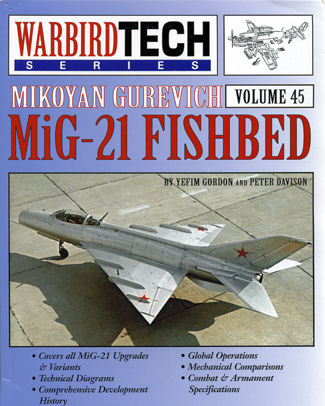 If one believes
the authors, since WWII, no other warplane has been built in greater number
(over 10,000) and has served in more air forces than any other fighter (the
C-130 has served in more and has been in production longer but isn't a fighter).
Surely a most enviable record for a fighter aircraft.
If one believes
the authors, since WWII, no other warplane has been built in greater number
(over 10,000) and has served in more air forces than any other fighter (the
C-130 has served in more and has been in production longer but isn't a fighter).
Surely a most enviable record for a fighter aircraft.
In 1953, while the Korean War was raging on, the Soviet
military was looking for a next generation fighter. MiG was tasked for this as
they had a wide variety of prototypes and specialty aircraft already, and had
done such a great job with its line of fighters that it was natural that they
continue.
They also had a reputation for getting things into the air
quickly. It was decided to develop a series of similar aircraft with different
wing configurations to see which would be the best in terms of speed and
maneuverability. This started with the Ye-2, which had a MiG-21 looking fuselage
with MiG-19 type wings. This was followed by the Ye-4 that had a triangular
delta wing. The Ye-50 was like the Ye-2, but had an auxiliary rocket motor. This
latter aircraft was not developed. It was finally decided on a Ye-4 derivative
and the MiG-21 was born.
The initial aircraft had but a canon and two missiles, but
was blindingly fast and able to reach altitude quite quickly. It also had a very
limited range and was basically a point defense interceptor. Eventually the
airframe was developed through a number of different variants until it matured
as a capable interceptor and fighter bomber, an aircraft that is still being
upgraded to even greater capabilities.
The authors are well known for their work on Soviet/Russian
aircraft and have done their usual superlative work on this book. We learn of
the different variants of the aircraft, the development of the two seat plane,
the rather large number that were and are built in China with all the different
Chinese variants. We also learn of its war record, one that isn't bad, but could
have been better. Then there are the upgrades to the airframe and foreign
operators. This is all further enhanced by a color photo section and a small
modelers section, which spends most of its limited pages talking about one kit
out of over 50! This is followed by several pages of drawings in the popular
1/112 scale of the five major variants.
Once again, an outstanding book from the fine folks at
Specialty Press. This is another MUST HAVE .
Review book courtesy of
 ,
where you can order your copy of this and many other superb aviation and
modeling books.
,
where you can order your copy of this and many other superb aviation and
modeling books.
If you would like your product reviewed fairly and quickly by a
site that has over 350,000 visits a month, please contact
me or see other details in the Note to
Contributors.
 If one believes
the authors, since WWII, no other warplane has been built in greater number
(over 10,000) and has served in more air forces than any other fighter (the
C-130 has served in more and has been in production longer but isn't a fighter).
Surely a most enviable record for a fighter aircraft.
If one believes
the authors, since WWII, no other warplane has been built in greater number
(over 10,000) and has served in more air forces than any other fighter (the
C-130 has served in more and has been in production longer but isn't a fighter).
Surely a most enviable record for a fighter aircraft.